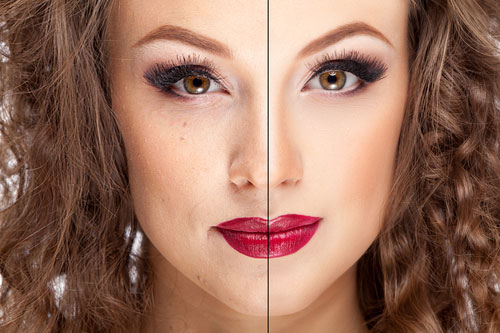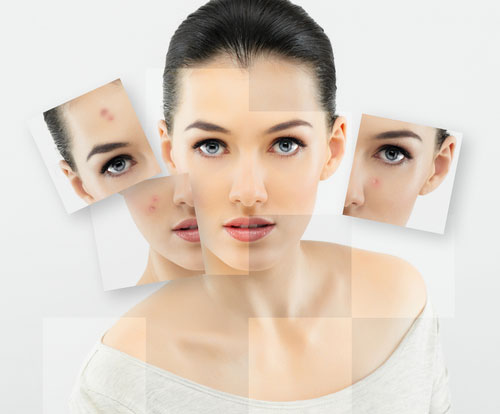After studying The Beauty DiaryI'm sure most of you have settled on a skin type that includes the word "dehydrated". Alas, dehydrated skin, i.e. unpleasant sensations, when after a simple washing with water the skin shrinks and your hands reach for a greasy cream, is the price we pay if we have an incorrect care regimen and uncontrolled enthusiasm for cosmetics.
Getting rid of the feeling of tightness is the main goal skin care. Skin dehydration is accompanied by fine lines around the eyes, skin color becomes dull, lifeless. All these signs are often mistaken for the first signs of aging on the face of women under 50. Women begin to fuss, go to cosmetic salons, do various, in fact, useless procedures that only exacerbate the problems. Although all the so-called "signs of aging" can be easily and simply corrected, if you make the right scheme of skin care.
All this fidgeting is like a person who has just opened a detective novel and is trying to guess how it will end and who the criminal really is. Unlike any detective, in which the end is sure to be, walking around the salon will end with the fact that the skin, if it is restored, then for a short time. And fussy will have to repeat and repeat endlessly these procedures. It is better to start skin care the way your skin wants it.
Dehydration, this does not mean that there is not enough tap, well or thermal water inside the skin, although the root of this word is "water". The skin has its own moisture, which is generated from within. If there is little of its own moisture inside the skin, the skin "deflates" as it were. Deprived of protection, the skin is exposed to various negative environmental influences. Therefore, care for dehydrated and sensitive skin must be well thought out.
Getting rid of dehydrated skin is also important for those who are going to treat problem skin. Since any external skin treatment involves strong drugs that irritate the skin. Therefore, it is very important to restore the skin before treatment, fill it with moisture and only then deal with your problems. Even the process of getting rid of black dots should be done on a restored, moisture-filled skin. Otherwise, sensitivity can be added to dehydration.
Sensitive skin - is a big problem for those who have it. If the skin reacts quickly with rashes, red dots, redness, itching to the application of cosmetic, products, it is safe to say that the skin is sensitive. 40% people in the world have sensitive skin. This skin condition makes it very difficult to choose skin care products. In essence, buying any cosmetic is tantamount to buying a "cat in a bag". Because every cosmetic can be a bomb for sensitive skin, when after cleansing or washing the skin pinches, burns, it is covered with red spots or small rashes. Of course, manufacturers have taken care of this type of skin, offering special cosmetics. But we are all individual, so often even the safest cosmetics can negatively affect the skin.
What to do? People with sensitive skin have only one solution - make a diary and write down the composition of all cosmetics that ever come into contact with the skin. Carefully check the composition of these cosmetics and identify the very ingredient that is most often found in the cosmetics used. There is a good chance that it is the identified ingredient that is the cause of allergies and irritations. Self-research will make it easier to choose cosmetics for sensitive skin. When buying should pay attention to the composition and do not buy those cosmetics that contain this unfortunate ingredient. Usually it is perfumes, preservatives or colorants.
Determine your skin type by The Beauty Diary.
Care for dehydrated and sensitive skin
Schematically, the scheme of care and restoration of dehydrated skin looks like this:
Evening:
- oil or petroleum jelly
- cleansing
- soak
- sour toning
- soak
- moisturizing
- soak
Morning:
- moisturizing only, no water
During the recovery period of dehydrated skin, it's important to remember the less your skin comes in contact with water, the better.
Cleansing by base oil or petroleum jelly
Cleansing is carried out with ordinary industrial washes with powerful surfactants. It is better to choose cosmetics that contain sodium laureth sulfate (sodium laureth sulfate) and cocamidopropyl betaine (Cocamidopropyl Betaine). This is especially true for those who use makeup. Decorative cosmetics have a complex composition and cannot be washed off with water or removed with oil or so-called light, gentle washes. The purpose of cleansing is to dissolve and then wash away all dirt and cosmetics from the skin.
However, just applying a cleanser and rinsing it off is not enough for dehydrated and especially sensitive skin. To avoid skin irritation, it is better to lubricate your skin with a base oil like sesame oil, macadamia oil, ginger oil, pumpkin seed oil, hazelnut oil, rice bran oil, but not jojoba oil or almond oil before cleansing. If you do not have these oils on hand, you can use virgin olive oil from the supermarket. But it must be in a dark greenish glass bottle with a slightly depressed bottom.
In addition to using base oils, you can also apply petroleum jelly to the skin before cleansing. The oil and petroleum jelly should be applied to dry skin. Jojoba oil is a wax and does not meet all the requirements for moisturizers. Almond oil has been shown to "tan" the skin, turning it into a dry mask.
Why choose this way of cleansing? Over the course of a day, a lot of dirt accumulates on the skin with a wide variety of chemical compositions. Some dirt can be washed off with water, some dirt can be cleaned with oily oils or creams, and some dirt can only be removed with industrial cleansers. In the proposed scheme of care - oil - cleanser - water - all three types of cleansers are present, which can be used to clean the skin well.
You can't wash your skin with soap: neither face nor body. We are talking about both solid and liquid soap. The composition of soap is such that whatever soap we choose, soap is still soap. That is, the basic composition of soap is preserved, despite the various aromatic or natural additives. The substances that make up the base of soap tend to react with substances that necessarily contain any water, whether hard or soft. As a result, an impenetrable film forms on the surface of the skin.
The best cleaner
Among all cleansers the best is Johnson & Johnson baby shampoo, because its formula, although not the safest, contains a combination of powerful surfactants that can wash away almost all dirt, including decorative cosmetics. You can, of course, pick up a cleanser and another brand. But its composition should be similar to children's shampoo.
Why should the skin be blotted?
After each contact of the skin with water, it should be blotted. Read A.N. Decina's research and you will appreciate the importance of this procedure. Simply put, there are microchannels inside the skin, which are "clogged" with water during washing. If you apply moisturizing cream or base oil immediately on wet skin, the water will not allow the fat to do its main job - to moisturize the skin. Therefore, after any water procedures and before applying any cosmetics it is necessary to remove water from the microchannels.
If you live in a dry climate or dry room, blotting your skin with a dry, clean tissue or towel is sufficient, as the dry air will help you remove any residual water. If the climate is humid or you are cleansing your skin in the bathroom, then the wipe should be warm so that the moisture from the skin evaporates faster.
Acid tinting with lactic acid
In the skin repair process, it is better to use products with lactic acid, which is part of the AHA acid complex along with glycolic acid, etc., as an acidic toner. We choose lactic acid because it is part of the chemical composition of the skin's natural moisturizing factor or NFM. In essence, lactic acid is the foundation of the skin's natural protective mantle. Once its percentage in the chemical composition of the NAF decreases, the skin begins to lose moisture. It is lactic acid that is used to restore the chemical balance of NAF.
Unfortunately, cosmetics manufacturers do not pay attention to lactic acid and practically do not add it to the composition of cosmetics. Therefore, we have nothing left but to use improvised means in the form of kefir, yogurt, curd whey, that is, to use any fermented milk products. However, using kefir or curd whey, you need to remember that lactic acid is still an acid. And like all acids, it has an exfoliating effect, and its improper use can lead to peeling, more tightness of the skin, and even to the appearance of red spots on the skin. Therefore, so that the skin is not flaked and crusted, we must be sure to dilute fermented milk products before use. We dilute kefir, sour cream, yogurt and sour milk 1 to 40 and above, curd whey - 1 to 60. To correct the acidity of the resulting mixture, you should use special litmus papers, which determine the level of acidity of the solution or pH. For the first weeks, the pH of diluted fermented milk products should not exceed 5.5 and fall below 3.5 in the following weeks and months of care.
The process of applying an acidic tonic:
after we have cleaned the skin and blotted, we apply diluted kefir or other sour milk products to the skin, spread evenly over the entire surface of the skin for 3-5 seconds no more. Then we rinse off the sour tonic. And again we blot the skin.
Moisturizing with petroleum jelly or base oil
Symptoms of dehydrated skin are tightness after washing with water or after cleansing, when your hands reach out to apply a greasy cream to the skin as soon as possible to "spread" the skin. In some cases, after washing with plain water on the skin appear red spots. And this is the first bell of sensitivity, when the body has to engage the immune system to fight irritants. A strong immune system is able to cope with this, but again, for the time being. And if the immune system is weakened, the skin quickly goes from dehydrated to sensitive.
It is better to apply petroleum jelly rather than mineral oil creams as a moisturizer during skin recovery.
Vaseline or mineral oil has two important properties: on the surface of the skin it does not oxidize, does not react with the environment, unlike creams, packed with a variety of ingredients, which lie on the skin all day, in contact with the environment, creating unpredictable chemical reactions on the skin.
The second important feature of Vaseline is its ability to form an impenetrable film on the skin, creating a kind of "greenhouse" effect, which prevents moisture from evaporating from the skin. By "moisture" of the skin we mean not tap water, mineral or thermal water, but the moisture that is "produced" by the skin itself. In order for the skin to fill the skin with moisture, we have to create a kind of greenhouse on the skin, inside of which the moisture so necessary for the skin will accumulate.
The use of petroleum jelly.
Rub hands so that they become warm, especially fingers. Apply petroleum jelly to warm hands and warm hands again, rubbing the palms of the hands smeared with petroleum jelly. As soon as the vaseline is soft, apply it to the skin, carefully, along the massage lines. Wipe off the vaseline residue after 10-12 minutes.
If you are emotionally uncomfortable keeping petroleum jelly on your skin, you can wash it off after a couple to three hours using the same pattern outlined above. Use a base oil as a moisturizer. Or you can leave the petroleum jelly on overnight and do a full cleansing routine in the morning, finishing with moisturizing with base oils. It's not bad if you apply powder or foundation on top to protect your skin.
Vaseline should not be overused. Use it in doses. For example, 3 days of petroleum jelly as a moisturizer, then a couple of days of base oil. It all depends on the condition of your skin and your tolerance to Vaseline.
What is the best petroleum jelly to choose?
Unfortunately, the quality of Vaseline in Russia leaves much to be desired. It has an unpleasant odor, suspicious consistency and yellowish color. This may indicate that petroleum jelly, which is a waste product from the refining of petroleum products, is poorly purified. Therefore, it is better to buy petroleum jelly somewhere abroad. Plastic surgeons in the United States after cosmetic procedures advise to use Vaseline by Aquaphor.
Why a base oil and not a cream?
Base oil belongs to the category of softening moisturizers or emollients. It creates a film on the skin, but unlike Vaseline, it is a permeable film. The skin does not suffocate under it. All base oils are applied with warm hands in the same way as Vaseline.
TOTAL:
Evening Care:
Oil
Cleaner
Soaking wet
Sour tonic
Soaking wet
Vaseline - 3 days and base oil on the remaining days
Soaking wet
Do not forget to be in a good mood during the skin recovery period, thinking only about your skin. No other thoughts should distract you during the skin treatment process. In your mind, thank your skin for being the best.
WARNING!
Forbidden apply oil or petroleum jelly to the eyelid area.
Forbiddenmoisturizing the skin to go beyond the ossicle.
No special eye care is required for the recovery period of dehydrated skin. After the skin is filled with moisture, it will tighten, become fresh, soft, smooth, and fine lines will smooth out by themselves.
All cosmetics are applied to the skin strictly along the massage lines.
When switching to a skin repair regimen, be careful. Especially if you have skin that is not only dehydrated but also sensitive. Before using cleansers, acidic toners or base oils, conduct skin tests by applying these substances to the skin on your wrist or elbow crease and leaving them on for 48-72 hours.
For the recovery period MUST sunscreen
During recovery, the skin may look ugly, it may become red, very flaky, crusty. So, inject more petroleum jelly.
If the skin is covered with red spots, it means that you have to dilute the sour tonic more. In this case, you should stop using sour-milk products for a while. And be sure to introduce petroleum jelly during this period.
During the recovery process, don't rush to use other irritants like salicylic acid, basiron or glycolic acid. Their turn will come, but a little later, when you move on to other stages. For now, your task is to make your skin healthy, fresh, smooth, firm.
The recovery process can take weeks or even months. Take your time, because the cell cycle, i.e. skin renewal, occurs every 30 days. Don't rush your skin. If you feel the process is taking too long, exfoliate your skin with glycolic acid.
Once the tightness has disappeared, you can move on to the other steps of skin caredepending on the problem at hand:
- you can start treating your problem skin
- If there is no inflammation on the skin, start fighting black spots, enlarged pores, oily skin or fine lines and wrinkles.
- If all problems have disappeared after recovery, switch to normal daily care with the inclusion of exfoliating treatments and the use of retinoids
- take care of the skin around your eyes
- Depending on your age, perform chemical peels
Pick one good cosmetics to take care of your skin. Read the article Oily skin care for oily skin with wide pores "orange peel".






[...] Another problem can be more serious when there is a small, round, bulb-shaped thickening at the tip of the hair that has fallen out. This means that the hair is falling out along with the bulb that nourishes it. That is, the hair does not get enough vitamins and minerals from inside the body. In this case, will perform a comprehensive care a for dehydrated and sensitive skin. [...]
Hello, dear admin! What happened to the program to make a mixture? does not open?